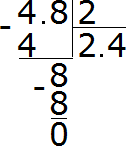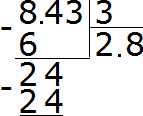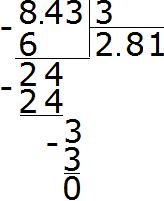A decimal, as we know, consists of a whole part and a fractional part. When dividing a decimal by a whole number, the first thing to do is:
- divide the whole part of the decimal by this number;
- after the whole part is divided, you must immediately put a dot in the quotient and continue the calculation as in the usual division.
For example, divide 4.8 by 2
Let's write this example with a corner:

Now divide the whole part by two. Four divided by two is two. Write the two in the quotient and immediately put a dot:

Now multiply the quotient by the divisor and see if there is a remainder of the division:

4−4=0. The remainder is zero. Zero is not written down yet, since the solution is not complete. Then continue to calculate, as in the usual division. Write down 8 and divide it by 2

8 : 2 = 4. Write the four in the quotient and immediately multiply it by the divisor:

The answer is 2.4. The value of the expression 4.8 : 2 is 2.4
Example 2. Find the value of the expression 8.43 : 3

We divide 8 by 3 and get 2. Immediately put a dot after the two:

Now multiply the quotient by the divisor 2 × 3 = 6. Write the six under the eight and find the remainder:

Then continue to calculate as in the usual division. Take off 4

Divide 24 by 3, we get 8. Write the eight in the quotient. Immediately multiply it by the divisor to find the remainder of the division:

24−24=0. The remainder is zero. Zero is not written down yet. Take the last 3 from the divisor and divide by 3, we get 1. Immediately multiply 1 by 3 to complete this example:

The answer is 2.81. So the value of the expression 8.43 : 3 is 2.81
2. If you find an error or inaccuracy, please describe it.
3. Positive feedback is welcome.